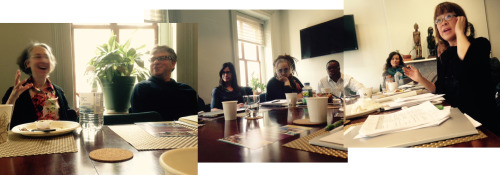A Framework for Reclaiming Aesthetics: A Preview of Coming Attractions!
Pam Korza
In 2014, ACSJN partnered with Animating Democracy, a program of Americans for the Arts and the Nathan Cummings Foundation to launch the Evaluation Learning Lab. The persistent call for practical frameworks and tools to describe and evaluate the social outcomes and aesthetic excellence of arts and justice work became the charge of the Lab, a group of 20 artists and ally evaluators and funders. Facilitated by Animating Democracy, the devoted A-Team (artists, Andrea Assaf, John Borstel, and Mark Valdez along with evaluator Chris Dwyer, RMC Research, funder Denise Brown, Leeway Foundation and Pam Korza, Animating Democracy) has spent the past year drafting the Aesthetics Perspectives framework with input and feedback from more than 125 people.
The framework’s creation is driven by the conviction that artists can and should self-determine the criteria by which their work is evaluated. It addresses a common assumption that artistic quality is secondary to or compromised by intent for justice, and the reality that standards relevant to different artistic and cultural and community-based practices have been dismissed or ignored in favor of dominant Eurocentric standards of excellence and beauty. While some have acknowledged the oppressive use of the term aesthetics, we are reclaiming the concept to take control of conversations that have historically excluded disenfranchised and oppressed people. We also assert that artistic quality matters, even as diverse perspectives make the assessment of excellence more challenging.
Titled, Aesthetic Perspectives: Attributes of Excellence in Arts for Change, the framework offers 11 aesthetic attributes that can be observed in arts and justice work. Equally relevant to artistic processes and outcomes, the attributes encompass both the external qualities and underlying values of such work. Animating Democracy and ACSJN have recently previewed the draft framework in lively exchanges with funders looking at issues of bias in panel processes; with artists, curators, educators, at the Creative Time Summit (see Jess Solomon’s post in this news edition!); and at an ACSJN local network gathering in Minneapolis held in conjunction with the Grantmakers in the Arts conference.
Here is a preview for you of the 11 aesthetic attributes! In the full framework, to be disseminated in early 2017, each attribute is presented with a conceptual summary and description, and a series of questions designed to help users apply the concept to specific work and contexts. For example, questions may guide various stages of work, e.g. project or program planning, assessment of proposed or completed Art for Change, and communication about the work, critical or reflective writing, creation of interpretive materials.
Commitment – Creative processes and products embody conviction to the cause espoused through the work.
Communal Meaning – The creative work facilitates collective meaning that transcends individual perspective and experience.
Disruption – The creative work challenges what is by exposing what has been hidden, posing new ways of being, and modeling new forms of action.
Cultural Integrity – The creative work evidences integrity and ethical practice in the use of material with specific cultural origins and context.
Emotional Experience – The creative work facilitates a productive movement between “heart space”—the emotional experience that art evokes—and the “head space” of civic or social issues.
Sensory Experience – Vivid sensations deepen the experience of the creative work and heighten the power of its messages and intentions for change.
Risk-taking – The creative work assumes risk by subverting dominant norms, values, narratives, standards, or aesthetics.
Openness – The creative work deepens impact by remaining open, fluid, transparent, subject to influence, and able to hold contradiction.
Resourcefulness – Imaginative use of available resources drives artistic innovation and demonstrates responsible social and environmental practice.
Coherence – Strong ideas expressed with clarity advance both artistic and social purposes.
Stickiness – Stickiness resides in the sustained resonance, impact, or value of the creative work.
Identification of these attributes is not meant to imply that arts and justice work requires an entirely distinct set of criteria, nor that conventional aesthetic attributes are irrelevant to an understanding of such work. Rather we suggest that augmenting the standard vocabulary of aesthetic categories with attributes of particular relevance to social change will afford deeper understanding, description, and appreciation of the qualities and rigor of art that aims for civic or social change and more equitable assessment of such work.
With the release of the framework in 2017, we’re looking for opportunities to engage artists; curators, arts presenters, programmers and writers; funders; evaluators; educators and students; and community partners to actively apply and adapt the tool for their purposes as well as engage in the concepts and questions embodies within it. Let us know by emailing Pam Korza (pkorza@artsusa.org) if you have an idea to include it in your work, a conference session, want to blog about it, or engage in another way!
Pam Korza co-wrote Civic Dialogue, Arts & Culture, and co-edited Critical Perspectives, an experiment in critical writing about socially engaged art. She co-leads Animating Democracy’s Arts & Civic Engagement IMPACT Initiative and the Assessing Practices in Public Scholarship research group for Imagining America. Pam is on the Leadership team of the Arts, Culture & Social Justice Network.


Leave a Reply